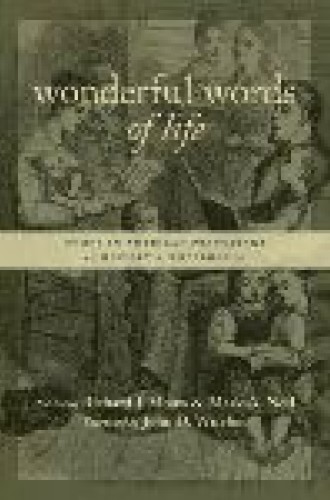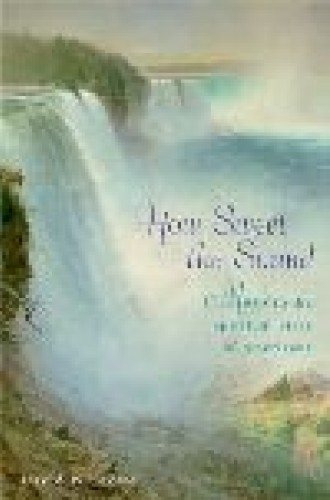Wonderful Words of Life/How Sweet the Sound
Hymnody and sacred music, long the domain of hymnologists and musicologists, have become hot topics in scholarship about American religion, and the “worship wars” of the 1980s and ’90s have sparked a reexamination of denominational hymn traditions by historians of American religion.
Richard Mouw and Mark Noll’s Wonderful Words of Life and David Stowe’s How Sweet the Sound represent two divergent directions in the new cultural interpretation of American sacred music.
Wonderful Words of Life is a collection of papers presented at a May 2000 conference on American Protestant hymnody held at Wheaton College’s Institute for the Study of American Evangelicals and funded by the Lilly Endowment. The essays lean heavily toward evangelical hymns, but in his introduction, Mouw, president and professor of Christian philosophy at Fuller Theological Seminary, points beyond the often assumed individualism of those texts to the neglected communal dimensions of evangelical hymnody. The collection ably accomplishes this task with essays that are original in research, diverse in theme and period, and stylish in presentation. This pioneering volume will reward any reader interested in how evangelical religion has been lived in the U.S.
Noll, a professor at Wheaton, opens with an essay on three “defining roles of hymns” in the 18th century: “hymns mediated between differences of class and race, . . . offered a public voice to women, and . . . functioned to pacify intra-evangelical disputes.” Esther Rothenbusch Crookshank follows with a fine overview of Isaac Watts’s impact on the early U.S. She shows that in addition to transforming the hymnody of Reformed worship, his works promoted the development of singing schools and tune books, introduced generations of children to “divine and moral songs” and supplied African Americans with sacred lyrics that have profoundly shaped the black church. Crookshank concludes that “Watts became the liturgist for a new nation.”
This achievement was not without some irony, as Rochelle Stackhouse illustrates in her study of two early American “national hymns,” Watts’s “Our God, Our Help in Ages Past” and Timothy Dwight’s “I Love Thy Kingdom, Lord.” In both cases, Stackhouse argues, hymns calling for believers’ allegiance to church over nation were “domesticated” into bland paeans to America by editors and pastors who dropped verses from the hymns, ignored their relationship to the Psalms and sang them in “entirely new contexts.”
A second group of essays discusses the role of hymns in missions and evangelism, as well as hymnodic crossovers among white evangelicals, Catholics and African Americans. Kevin Kee and Thomas Bergler provide insightful pieces contrasting the use of music as entertainment in early-20th-century Canadian revivalism with the development of pop-style praise songs as evangelistic tools in the roughly contemporary Youth for Christ movement in the U.S. Felicia Piscitelli and the late Virginia Lieson Brereton present a quite different contrast in their essays on Catholic appropriation of Protestant hymns and white Protestant acceptance of black gospel music.
Wonderful Words of Life concludes with three essays on hymnodic theology. Jeffrey VanderWilt’s challenging piece carefully reconstructs the major tropes of death, heaven and judgment in evangelical hymnody. Susan Wise Bauer offers a nuanced analysis of narrative songs of experience and systematic doctrinal hymns in the evangelical tradition and “reclaims a confidence” in narrative hymnody because it “makes a theological statement too complex and painful to be put into systematic form, yet too important to be ignored.” Mouw offers a telling critique of recent interpretations of nautical rescue themes in gospel hymns as psychologically passive and socially retrograde.
Whereas Wonderful Words of Life treats the dominant hymnodic tradition in the U.S., How Sweet the Sound is a bold expedition to the historical and stylistic limits of American sacred music that contests received categories and offers fresh, often controversial interpretations.
Stowe, associate professor of writing, rhetoric and American cultures at Michigan State University, supplements the cultural historian’s customary interdisciplinary toolkit with ethnomusicology, anthropology, literary criticism and folklore studies, applying these methodologies with postmodern brio to a remarkable range of American sacred music. The result is not a comprehensive survey but a series of “exemplary interlinked case studies to convey something of the range of religious and musical expression.”
Viewing sacred music as “a product of cultural exchange,” “a response to power” and “equipment for living under adverse conditions, but also as an instrument of power,” Stowe joins other contemporary cultural historians who rethink “national narratives by adopting a simple dictum: to follow the people, the money, the ideas, the things, all of which have a stubborn tendency to ignore national boundaries.”
Stowe’s chase proves to be quite a romp indeed. It begins with a chapter on the hymns of Isaac Watts and Charles Wesley that emphasizes the continuous process of revision and retranslation of the Psalms in the 18th-century U.S., and ends with a meditation on the extraordinary “panreligious” musical fusion of mid-20th-century jazz saxophonist John Coltrane and his influence on rock groups and American minimalist composers. Along the way Stowe writes compellingly about other innovators in sacred music, typically in pairs of “interlinked examples.” These include the Shakers and the Mormons; the D. L. Moody–Ira Sankey partnership and the Fisk Jubilee Singers; the Ghost Dance and the American ethnomusicologists who studied it; Al Jolson and the great Reform Jewish cantor Yossele Greenblatt; and—perhaps the greatest stretch of all—Conrad Beissel, founder of the 18th-century pietist community at Ephrata, Pennsylvania, and Sun Ra, esoteric Afrocentrist and futurist leader of the 1950s big band called the Arkestra.
All of this is original, thought-provoking and thoroughly entertaining. Stowe writes vividly and has a genuine gift for uncovering unlikely cultural connections that have shaped American sacred music. Most important, his central contention that the key to understanding American sacred music lies in cultural processes rather than historical traditions is not easily gainsaid. This is a major claim that deserves much further inquiry, and Stowe has provided ample material and innovative interpretations to show the way.
Yet sometimes Stowe’s narrative is simply too imaginative for its own good. Buried in these fascinating accounts are exaggerations of fact, dubious textual and musical parallels and, most troubling, occasional acknowledgments that the evidence for his claims is “scanty” or, frankly, “unknown.” The main reason for these difficulties is not deficiency of research. Rather, some of Stowe’s more adventurous interpretive leaps rely on apparent rhetorical or analogical parallels that cannot be sustained fully by historical demonstration or attribution.
The cultural-process model works better for some of Stowe’s examples than others. It makes excellent sense of the musical crossovers of Buddhists in the U.S. and of Coltrane’s musical synthesis at a moment of incipient cultural globalization. But there are interpretations specific to the American national narrative that can speak more directly to the negotiation of the sacred-secular boundary and the racial divide. And the historical sociology of American religious sects suggests that the parallel religious, musical and sexual experiments of the Shakers and Mormons and of Beissel and Sun Ra were not matters of “remarkable” or “uncanny” coincidence but rather part of a national tradition of charismatic and esoteric movements.
Perhaps it is best to think of this lively and stimulating book as a landmark in cultural criticism rather than in the cultural historiography of American sacred music. The “American lives” of its subtitle are principally those of poets, musicians and composers whose spirituality, according to Stowe, is more closely aligned with artistic creativity than the expression of popular religion. Although Stowe’s book is not convincing as a historical account, it does demonstrate that an understanding of underlying cultural processes is essential to cultural criticism of American sacred music and its creators. It is this new and exciting critical prospect that makes How Sweet the Sound the most original book on American sacred music in years.







